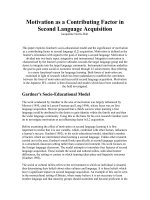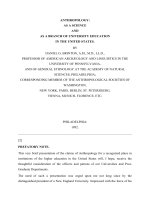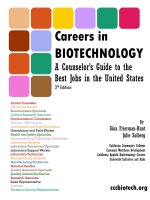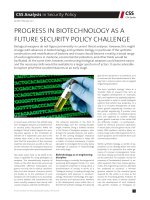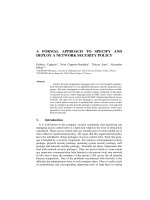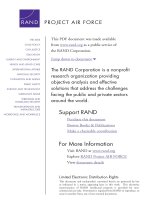PROGRESS IN BIOTECHNOLOGY AS A FUTURE SECURITY POLICY CHALLENGE
Bạn đang xem bản rút gọn của tài liệu. Xem và tải ngay bản đầy đủ của tài liệu tại đây (228.95 KB, 3 trang )
CSS Analysis in Security Policy
ETH Zurich
CSS
No. 88 • February 2011
PROGRESS IN BIOTECHNOLOGY AS A
FUTURE SECURITY POLICY CHALLENGE
Biological weapons do not figure prominently in current threat analyses. However, this might
change with advances in biotechnology, and synthetic biology in particular. If the synthetic
construction and modification of bacteria and viruses should become a reality, a broad range
of useful applications in medicine, environmental protection, and other fields would be
facilitated. At the same time, however, constructing biological weapons could become easier,
and the necessary skills would be available to a larger spectrum of actors. It seems advisable
to explore preventive countermeasures at an early stage.
In recent years, attention has shifted away
from biological weapons and bioterrorism
in security policy discussions. While the
biological threat briefly topped the secu-
rity-policy agenda in the immediate af-
termath of 11 September 2001 due to the
anthrax letter scare, it has since become
clear that the acquisition of the necessary
expertise and resources as well as the suc-
cessful execution of a biological attack are
far more complex than previously believed.
Non-state actors have so far failed to de-
velop a capability for using pathogens as
weapons. The overwhelming majority of
states, on the other hand, have consciously
relinquished offensive bioweapons pro-
grams not only due to ethical considera-
tions, but also because of serious, persist-
ent doubts as to the usefulness of such
weapons (cf. CSS Analysis no. 5). According-
ly, current debates and controversies over
mass casualty weapons deal mainly with
nuclear weapons and their proliferation.
The advances expected in the field of
biotechnology over the coming decades
might, however, bring a marked increase
in the threat of biological weapons. Even
though the possible features and poten-
tial of the coming biological revolution
heralded by many observers is today still
a matter of intense controversy, it seems
advisable to investigate the security policy
challenges of advances in biotechnology
at an early stage.
Biotechnology as an engineering
discipline
Biotechnology is currently the vanguard of
promising technological trends. It is seen
as having the potential to bring about a
transformation of society in terms of a
“biological century”, including through the
convergence with advances in nanotech-
nology, information technology, the cogni-
tive sciences, and neurosciences. Nowhere
is this development more visible than in
the field of synthetic biology. The declared
goal of this discipline is as ambitious as it
is controversial: the transformation of biol-
ogy from a natural science into an applied
engineering discipline.
The term “synthetic biology” refers to a
scientific field of research that aims at
the targeted development of molecules,
cells, and organisms by applying engineer-
ing principles in order to create biological
systems that exhibit new properties. In a
way, it is a further development of tradi-
tional genetic engineering. However, un-
like genetic engineering, it involves more
than just a transfer of individual genes
from one organism to another. Instead,
genes, genetic modules, or the entire DNA
are artificially created – or synthesised –
based on chemical precursor substances.
In recent years, this has given rise to a full-
blown DNA synthesis industry. Many sci-
entists today order DNA fragments for re-
search purposes via the internet from such
commercial providers.
Within synthetic biology, a number of ap-
proaches can be distinguished. One basic
possibility is to synthesise the entire ge-
nome of a known microorganism. Scien-
tists have already successfully reconstruct-
ed the poliovirus, for example, mainly for
purposes of fundamental research. In an-
other approach that more closely approxi-
mates the engineering sciences, attempts
are underway to construct a minimal
genome reduced to the essential genes
required for life, which is to serve as the
chassis for mounting genetic modules. At
the same time, there is intense research
into the development of such standard-
ised genetic modules or “biological cir-
© 2011 Center for Security Studies (CSS), ETH Zurich
1
iStockphoto.com
CSS Analysis in Security Policy
No. 88 • February 2011
cuits” that can be added to the minimal
genome in order to carry out predefined
tasks – along the lines of modular con-
struction in many industries, such as the
car or computer industries. That would,
for instance, allow the chassis organism to
generate specific metabolic pathways or
other desired characteristics.
Promising applications
Synthetic biology promises to make the
pursuit of biotechnology and especially
the modification of biological systems
easier, faster, cheaper, and more accessible
to “non-experts” through recourse to the
engineering principles of standardisation
and modularisation. The number of pos-
sible users of biological techniques might
increase markedly – while at the same
time, the resources required to modify
biological systems would be pared down.
The reliability of biology-based technology
is likely to increase considerably and the
time needed to translate scientific insights
into practical applications could thus be
significantly reduced.
If the advances made hitherto should con-
tinue unabated, the consequence would
be a significant change in how, and to
which extent, modern-day biotechnology
is conducted. Already today, a number of
potentially beneficial applications are in
the offing. For example, there is the justi-
fied expectation that the technology could
pave the way for the production of biofu-
els or certain medicinal substances in bac-
teria – as final products of their metabo-
lism – or for breaking down environmental
pollutants through a specially constructed
bacterial metabolism. Researchers have al-
ready succeeded in producing an antidote
to malaria within bacteria. It is also con-
ceivable that bacteria could be construct-
ed to indicate the presence of certain sub-
stances such as explosives or radioactive
material, which would make it easier to
implement certain protection measures.
A double-edged sword
Much as in the case of the nuclear revolu-
tion, however, progress in biotechnology
brings not only social benefits, but also
risks. The core challenge of biotechnol-
ogy in terms of security policy involves the
dual-use problem. Many if not most bio-
technological approaches can be used not
only for beneficial, but also for malicious
applications. Virtually all security-relevant
developments in biotechnology can be de-
rived from completely legitimate research
efforts and adapting them for nefarious
purposes does often not involve any sig-
nificant detours.
As far as DNA synthesis is concerned, there
is an obvious risk of the technology being
misused for recreating dangerous patho-
genic agents. The necessary genetic se-
quences are publicly available in internet
databases. While the procurement of such
agents from nature is still the easier and
cheaper method today, that may change.
In addition, certain pathogens such as
Ebola or Marburg are difficult to isolate
in nature. Others, in turn, no longer exist,
but could be synthetically reconstructed.
Among the extinct viruses that could be
used as potent bioweapons are the Variola
virus (smallpox) or the pandemic influenza
virus of 1918, both of which killed millions
of people.
Synthetic biology could also make it easier
in the long term to modify the properties
of pathogenic agents by making them
more suitable for weaponisation through
“insertion” of suitable genetic modules.
Apart from imparting resistance to medi-
cine, however, the modification of biologi-
cal attributes in viruses or bacteria is not
yet sufficiently controllable. Our under-
standing of the functions of individual
genes and their interaction is still rudi-
mentary. However, in the long run, proper-
ties such as virulence, infectiousness, and
environmental stability may also become
subject to modification.
The ability to modify biological systems
as desired – currently still a hypothetical
scenario – would make the development
of biological weapons more attractive for
military or terrorist purposes. Current tac-
tical obstacles to their deployment could
be partially removed, for instance by mak-
ing biological weapons more controllable,
i.e., suitable for selective and targeted use.
Also, some operational difficulties with
their use, such as the degradation of a
pathogen through various environmental
factors, could be diminished. Furthermore,
the development of bacterial metabolic
pathways could in the future permit the
production not only of beneficial sub-
stances, but also of toxins, drugs, counter-
feit medicines, or precursor substances for
chemical weapons.
Such misuse of applications does not in-
herently depend on specific developments
in synthetic biology and could theoretically
also be achieved by way of alternative bio-
technology options. Advances in synthetic
biology might however make them availa-
ble sooner, and facilitate acquisition of the
necessary capabilities over the longer term.
Inadequacy of current
instruments
In the short and medium term, the threat
of nefarious use of synthetic biotechnol-
ogy is small, and it is largely limited to
states that can invest the resources nec-
essary for further development of this
discipline and wish to do so. Nevertheless,
should biotechnology applications indeed
become easier and more affordable to use
in the future, the risk of misuse through
other states and especially non-state ac-
tors can be expected to grow considerably.
As biotechnology becomes easier to per-
form and more widespread, the problem
of proliferation of offensive bioweapons
capabilities will come to the fore. The in-
ternational norm against the use and pro-
liferation of bioweapons is in danger of be-
ing eroded by these developments.
Modern societies are largely unprepared
for the security policy challenges of ad-
vances in biotechnology. The increasing
penetration of society with biotechnologi-
cal capabilities requires a more compre-
hensive political response than is currently
the case. Already today, the effectiveness of
traditional arms control mechanisms such
as international treaties or national export
control regimes in the field of biological
weapons is limited. Due to the problem
of dual use, it is nearly impossible even to
identify, let alone to control bioweapons-
related activities. This is one of the reasons
© 2011 Center for Security Studies (CSS), ETH Zurich
2
US Presidential Commission for the
Study of Bioethical Issues: The Ethics
of Synthetic Biology and Emerging
Technologies
US National Science Advisory Board for
Biosecurity: Addressing Biosecurity Con-
cerns Related to Synthetic Biology
OECD: Symposium on Opportunities
and Challenges in the Emerging Field of
Synthetic Biology
EU Research Framework Programmes:
Synbiosafe (Synthetic Biology Safety
and Ethical Aspects)
SYBHEL (Synthetic Biology for Human
Health: Ethical and Legal Issues)
Synth-Ethics (Ethical and Regulatory
Issues Raised by Synthetic Biology)
United Nations Interregional Crime
and Justice Research Institute (UNICRI):
Synthetic Biology and Nanobiotechnol-
ogy Risk and Response Assessment
Important documents and initiatives
CSS Analysis in Security Policy
No. 88 • February 2011
why the international community has so
far been unable to agree on a verification
mechanism in the framework of the Bio-
logical Weapons Convention (BWC) such as
those that exist for chemical and nuclear
weapons. Research that is of relevance to
biological weapons can easily be hidden
under the guise of legitimate activities
and conducted in the type of small civilian
laboratories of which there are hundreds of
thousands worldwide. The sheer number
of installations that would need to be
monitored would preclude even the sem-
blance of a credible inspections regime.
The limitations of arms control mecha-
nisms such as the BWC will become even
more apparent once the bioweapons
threat from non-state actors increases.
Such a scenario seems plausible, since the
proliferation of biotechnological capabili-
ties throughout society is inexorable. Im-
posing limits on advances in biotechnology
would hardly seem appropriate in view of
the huge potential benefits of this disci-
pline, and would also not be feasible in
practice. The expertise, material, and equip-
ment are used across many life science
disciplines and are – to varying degrees –
already widely available around the world.
In this sense, the proliferation of biotech-
nological knowledge and material, though
not specifically weapons-related, is already
underway. The geographic and societal-
sectoral proliferation of biotechnological
expertise is therefore hardly reversible at
this stage.
Innovative approaches required
Against this background, it is becoming
apparent that the security-policy chal-
lenges of biotechnological developments
can only be tackled with a comprehensive
response and innovative approaches. In-
stead of the traditional focus on attempt-
ing to deny access to knowledge and tech-
nologies, a broader approach should be
pursued that also engages relevant social
groups and actors and enables them to
discover and report misuse.
What is required is the installation of
an integral network of top-down politi-
cal steering and regulating mechanisms
on the one hand and bottom-up initia-
tives for self-regulation of interest groups
on the other. Such a “Web of Prevention”
would consist of national and interna-
tional efforts, initiatives, and activities at
various levels of intervention involving all
relevant actors. That would shift the fo-
cus towards sharing responsibility among
politics, science, business, and society at
large.
In analogy to the Hippocratic oath, which
is taken as a matter of course in the medi-
cal disciplines, the field of biotechnology
must also create a culture of responsibil-
ity and awareness of risks. However, such
a comprehensive approach, which would
probably be unique in the history of arms
control, would require a shared vision and
flexible strategy as to how the various ac-
tors and initiatives could be systematically
integrated. Clearly, such a consensus can
only take root if all relevant stakehold-
ers are sensitised to the security-relevant
dual-use aspects of research in biotech-
nology.
In this context, it is encouraging to see
that those dealing with synthetic biology
have adapted a highly proactive approach
to ethical and security-relevant issues. Not
least in response to widespread scepti-
cism towards genetic engineering, many
protagonists in the field are unabashed
about tackling such issues and actively
engaged in public discourse. Students,
who are increasingly becoming involved in
this discipline, are confronted with these
issues at an early stage.
So far, the most concrete efforts have
been made by the DNA synthesis industry.
As a self-regulating effort, these compa-
nies voluntarily – and so far, without sig-
nificant government assistance – perform
checks as to whether DNA orders are con-
gruent with the genetic sequence of path-
ogens. If this is the case, the customer will
be screened and the order refused unless
there are legitimate reasons for procuring
such a sequence.
All these efforts are laudable, but much
more needs to be done to secure the fu-
ture of biotechnology – not only with
regard to synthetic biology, but also con-
cerning the bioscience and technology
field as a whole. The goal of such preven-
tive measures should be to maximise the
unfettered development of the many ben-
eficial applications of biotechnology while
simultaneously minimising the danger of
harmful developments. It is important to
remember that the net effect of develop-
ments in biotechnology could certainly
prove to be advantageous – also in terms
of countering the bioweapons threat
– and that beneficial applications thus
should be considered an important vari-
able in the overall risk assessment.
© 2011 Center for Security Studies (CSS), ETH Zurich
3
The DNA synthesis industry
Several international DNA synthesis corporations have joined forces in two industrial
consortia, each of which has elaborated a “Screening Framework” for reviewing orders and
customers.
International Association Synthetic Biology (IASB): Code of Conduct for Best Practices in
Synthetic Biology
International Gene Synthesis Consortium (IGSC): Harmonized Screening Protocol to Pro-
mote Biosecurity
The US government has also formulated non-binding recommendations for screening
in support of these initiatives: Screening Framework Guidance for Providers of Synthetic
Double-Stranded DNA
International Genetically Engineered Machine (iGEM) competition
iGEM is an annual student competition in synthetic biology. The participating international
teams are obliged to document any safety-relevant aspects related to their project. There
are also plans to develop a code of conduct.
Biosafety (unintended release) Biosecurity (intentional release)
Amateur biology
In the context of modern-day biology, there is a growing community of amateur biologists
or “biohackers” who conduct biological work outside of conventional research institutions
similar to the beginnings of the IT industry. Members of this community are also actively
engaged in the security discourse and in elaborating a Code of Conduct .
Self-regulation initiatives in synthetic biology
Author: Sergio Bonin
Responsible editor: Daniel Möckli
Translated from German:
Christopher Findlay
Other CSS Analyses / Mailinglist:
www.sta.ethz.ch
German and French versions:
www.ssn.ethz.ch
